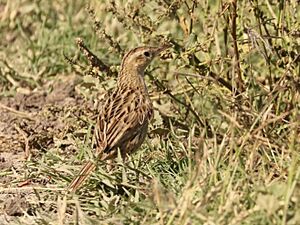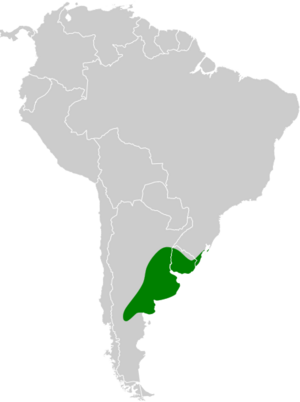Hudson's canastero facts for kids
Quick facts for kids Hudson's canastero |
|
|---|---|
 |
|
| at Dolores, Buenos Aires, Argentina | |
| Conservation status | |
| Scientific classification | |
| Genus: |
Asthenes
|
| Species: |
hudsoni
|
 |
|
The Hudson's canastero (Asthenes hudsoni) is a small bird that lives in grasslands. It's part of the ovenbird family, called Furnariidae. This bird is found in parts of Argentina, Brazil, and Uruguay. It's considered a Near Threatened species, which means its population needs careful watching.
Contents
What's in a Name?
The Hudson's canastero is a unique species, meaning it doesn't have different subspecies. It's very similar to another bird called the austral canastero. These two birds are like "sister species" because they are closely related.
The bird's English name and its scientific name, hudsoni, honor a famous naturalist and writer. His name was William Henry Hudson, and he was from Argentina and Britain.
What Does It Look Like?
The Hudson's canastero is about 18 centimeters (7 inches) long. It's one of several canastero birds that have dull colors. They have dark stripes on their upper bodies. This bird has a long beak. Both male and female birds look the same.
Adult birds have a thin, pale, buff-colored stripe above their eyes. Their face is sandy brown. Their head and upper body are sandy brown with clear blackish and silvery stripes. Their wings have dark brown feathers with whitish tips. Other wing feathers are dark brown with wide reddish-brown edges.
Their flight feathers are dark and brownish-black. The tail is dusky (dark gray-brown) with clear silvery-buff edges on the feathers. Their chin is whitish, sometimes with a yellow or reddish-orange tint. Their throat, chest, and belly are buff-colored. This color is richer on their sides and under their tail. Their sides have blackish stripes.
Their eyes are light brown. The upper part of their beak is brownish-black. The lower part of their beak is pale horn-colored to gray with a black tip. Their legs and feet are light brownish. Young birds have blackish-brown stripes on their chest and sides.
Where Does It Live?
Hudson's canastero lives in southeastern Rio Grande do Sul state in Brazil. It also lives in Uruguay and eastern Argentina. In Argentina, it's found from Santa Fe and Entre Ríos provinces down to Buenos Aires Province.
This bird lives in temperate grasslands. These areas are usually close to marshes, which can be fresh or salty. It prefers places with tall grasses, like Paspalum quadrifarium, and sedges. These tall plants are mixed with short grass or bare ground. It can live from sea level up to about 950 meters (3,100 feet) high.
How Does It Behave?
Movement and Migration
People used to think that Hudson's canastero stayed in the same place all year. However, a recent study showed that it actually migrates! Most of the birds that breed live in the pampas region of Buenos Aires. There's also a small group in Rio Grande do Sul. Birds found further north in Argentina and all birds in Uruguay are usually there for the winter.
What Does It Eat?
Hudson's canastero eats adult and young arthropods, which are creatures like insects and spiders. It looks for food alone or in pairs. It picks its prey off the ground and from low plants.
Reproduction and Life Cycle
Hudson's canastero breeds during the spring and summer in the Southern Hemisphere. This is usually between October and December. Scientists believe that these birds are monogamous, meaning they have one partner.
They build a well-hidden, dome-shaped or round nest. It's made of grasses and twigs. The nest is built over a hollow in the ground or very close to it, hidden in a clump of grass. They line the nest with feathers, hair, and small twigs. A female usually lays three or four eggs, but sometimes it can be two to five. We don't know how long the eggs take to hatch or how long it takes for the young birds to leave the nest. We also don't know much about how the parents care for their chicks.
What Does It Sound Like?
The song of Hudson's canastero is described as "a short ascending trill." This means it's a quick, rising sound. Its call, which is a different sound, has not been described yet.
Why Is It Near Threatened?
The IUCN (International Union for Conservation of Nature) first said Hudson's canastero was of "Least Concern" in 2004. But since 2011, they have changed its status to "Near Threatened." This means it's not in immediate danger, but its population is decreasing.
Even though it lives in a large area, we don't know exactly how many birds there are. The main threat to this bird is the ongoing loss of its grassland home. These grasslands are being drained and turned into farms or city areas.
The bird can still live in cattle pastures, but its main habitat is disappearing quickly. It's considered uncommon, but in some local areas, it can be fairly common. Since it needs wetlands, its population size is naturally limited. It's also at risk from pollution and other problems that affect birds living in wetlands. The discovery that it migrates makes it even more important to study its population and how it's changing.


